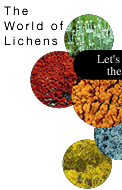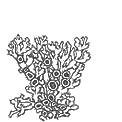

■How do lichens reproduce?
Lichens reproduce themselves in two ways. One is by spore-based reproduction in which germinating spores, produced in apothecia or perithecia.develop to form a new body after finding the same symbiotic algae that its parent belonged.
Apothecium is a dish-shaped reproductive organ formed on the surface of thallus (fig. 4). It only produces spores of fungi (mycobiont). Colors and shapes of apothecia vary according to genera of lichens. In case of Graphis, the shape of its apothecia is like letters written on a piece of paper (fig. 4b).
Fig. 4:
different shapes of thallus. a: Hypogymnia physodes, b: Graphis scripta, c: Anthracothecium oculatum, d: Cladonia macilenta |
|
| ● fig.5a: soredia | ● fig.5b: isidia |
■Colors of lichens
Colors of lichens vary from gray, light green to orange, depending on chemical substances each lichen contains. If it contains a pigment called usnic acid, its color turns out yellow; in case of a pigment of anthraquinon, the color will be orange; others will turn gray. So, by looking at the colors of lichens, it is possible to judge roughly the types of pigments they contain (fig. 6).
| ●fig. 6a: crystals of sekikaic acid | ●fig.6b: salazinic acid |
| ●fig.6c: alectoronic acid |
■Lichens found in Japan
About 1800 species of lichens are growing in Japan. How many species of lichens can grow in a mountain will depend on the size and the height of the mountain, and varieties of its vegetation. In big mountains like Mt. Fuji and Mt. Akan, usually more than 250 species are known to grow. If a mountain is forested with plantation trees such as Cryptomeria japonica and Chamaecyparis obtusa, the number of lichen species are limited. Whereas, the number of lichen species are more abundant in natural forests of Fagus crenata, Quercus crispula and Abies mariesii. In natural forests, there are many factors which encourage the growth of wide varieties of lichens. For instance, natural forests provide many kinds of trees and shrubs as substrates; they produce abundant fallen trees and forest floors that renew naturally. Hence, there are varieties of micro-habitats where different lichens are able to grow.
Japan is longitudinally elongated: in northern Japan and mountains of 2000 m and above, cool temperate forests prevail. Whereas in the south, subtropical forests spreads so as to give wide varieties of environments where varied lichen species can exist.
Introduced below are the typical lichen species that grow in main vegetation zones in Japan.
■Lichens in alpine zone (Pinus pumila forest)
Thamnolia vermicularis, Umbilicaria leiocarpa and Cetraria ericetorum etc. are grown here. Many of the lichens growing in the area from Pinus pumila forest to the forest limit are similar to the species growing in high latitudes in the Northern Hemisphere (fig. 7).
| ●fig.7a: Umbilicaria cylindrica in Mt. Daisetsu | ●fig.7b: Crustose lichens in Mt. Daisetsu |
■Lichens in subalpine coniferous forest
zone
Hypogymnia hypotrypa, Peltigera aphthosa, Rhizocarpon geographicum, Usnea
longissima etc. are the main species. Many of them are the species widely
distributed in cool temperate zones in the Northern Hemisphere.
| ●fig.8a: Hypogymnia hypotrypa in Mt. Fuji | ●fig.8b: Usnea longissima in Mt. Nantai |
| ●fig.8c: Bryoria americana in Mt. Fuji |
Anzia japonica, Graphis rikuzensis, Myelochroa irrugans, Lobaria spathulata, Lecanora sibirica, Viridothelium cinereoglaucescens, Usnea diffracta, etc. are the species seen in these forests. Many species in these forests are endemic to Japan and the East Asia.
■Lichens in mountains lower than 500m
Cladonia conista, C. ramulosa, Flavoparmelia caperata, Parmotrema tinctorum,
Pyxine endochrysina, Rimelia clavulifera, etc. are seen in the areas (fig.
9). Many of them are widely distributed in temperate regions in the Pacific
regions.
| ●fig.9a: Parmotrema tinctorum in Mobara, Chiba Pref. | ●fig.9b: Cladonia kurokawae in Shiojiri City |
| ●fig.9c: Cladonia ramulosa in Takada City |
■Lichens in urban areas
Species like Dirinaria applanata, Candelaria concolor, Caloplaca sp. Endocarpon
petrolepideum, Physciella melanchra, Lepraria sp. which can endure arid
condition and air pollution are seen in the areas (fig.10a).
■Lichens widely distributed
from hills to high mountains
Cladonia rangiferina, Cladonia arbuscula, Huillia albocaerulescens
etc. (fig. 10 b & c).
■Lichens in warm regions south
of Yakushima
Many species such as Coenogonium, Parmeliella mariana, Strigula elegans
(belonging to foliose lichens), Pyrenula gigas, etc. which grow in tropical
to sub-tropical zones are seen.
| ●fig.10a: Candelaria concolor in Tsukuba City | ●fig.10b: Cladonia rangiferina in Tokai-mura |
| ●fig. 10c: Porpidia albocaerulescens in Tsukuba City | ●fig. 10d: foliicolous lichens in Iriomote Is. |
Lichens can grow under extremely harsh conditions that other plants cannot tolerate. Even in extremely cold areas such as the Antarctic and the arctic regions, where the sun shines only half a year, and the landscape is covered with ice and snow most of the year, lichens can grow. Or, in high mountains of Himalayas and Andes,where climate is arid and cold enhanced by strong winds, there are many lichens. Also, lichens can be seen in deserts where there is hardly any rainfall for many years. Why can lichens grow in such harsh conditions? The answer lies in high potency of lichens to endure aridity and wide range of temperature changes. When they are exposed to low temperature or dry conditions, they reduce the amount of breathing so as to limit the consumption of energy for many years (fig. 11).
| fig.11: Thamnolia vermicularis and Cladonia stellaris in Mt.Chubetsu, Hokkaido, |
